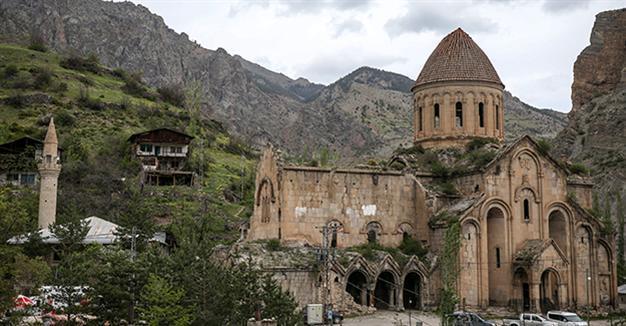Georgian monastery in Turkey's Erzurum awaits more visitors
ERZURUM – Anadolu Agency

AA photo
The Öşvank Monastery in the eastern province of Erzurum’s Uzundere district, which dates back around 1,000 years, has been attracting local and foreign tourists who come for its religious significance and architectural features.The monastery, built by Georgian King Curopalate Adernese’s sons between 963 and 973, includes inscriptions giving details about the construction process of the building, as well as decorations quoting the Bible.
Many local and foreign tourists, led by Georgians, visit the monastery every year.
Prof. Haldun Özkan of Atatürk University’s Art History Department said the monastery was one of the most significant cultural heritages around Erzurum.
“The monastery is very significant in terms of its plan, architecture and decorations,” he said. “I call it ‘Hagia Sophia of the East.’”
Özkan said gothic and baroque motifs could be seen in the Öşvank Monastery centuries before they appeared in European architecture.
“We can see the gothic motifs, which will appear around 200 years later, and baroque motifs, which were used 500 years later, in this 10th-century church,” he added.
According to Özkan, another significant aspect of the church was its inscriptions, which provided a detailed account of the construction process.
“Thanks to these inscriptions, we know the name of the architect: Grigol of Öşk,” he said.
“This architect, with the help of the villagers, built a monumental work of art. The inscriptions give details of how the stones were carried from quarries with ox-carts and the works of a group of 80 stone masters.”
The professor said thanks to its strong foundations, the monastery managed to survive for some 11 centuries, but stressed it needed urgent restoration.
“The current situation of the monastery does not suit its glory,” Özkan said.
“With its restoration, it may significantly contribute to tourism in the region. Turkey, and especially Erzurum, should make use of this potential,” he added.
One of the most significant historical structures in eastern Anatolia, the Öşvank Monastery dedicated to St. John the Baptist is in the village of Çamlıyamaç. It was constructed between 963 and 973 and was donated by the Bagratid brothers, the sons of the Georgian Curopalate Adernese, King David and Prince Bagrat.
During the time the region was under the reign of the Byzantine emperors, the dome of the church was repaired by Basil II and Constantine VIII. In the 11th century, the monastery was one of the most important bishoprics in the region and a center of culture, especially famous for its manuscripts. It preserved its importance until the end of the 15th century. At the end of the 19th century, the church was converted into a mosque and functioned as a place of worship until 1980. In 1985 the Culture Ministry designated it a monument to be protected and preserved and included it on its national heritage list.
















